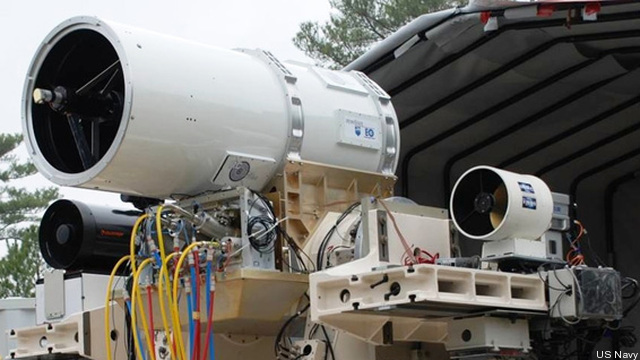The Limits Of Lasers: Missile Defense At Speed Of Light
Posted on

WASHINGTON: Ronald Reagan’s dream of lasers that can shoot down incoming missiles is about to become reality — to an extent. The Navy will deploy a low-power prototype to the Persian Gulf this summer and it sees real potential to zap drones, small boats, and anti-ship cruise missiles. But experts assembled at this week’s Atlantic Council conference on missile defense agreed that directed energy weapons are decades from making a dent in much faster and tougher ballistic missiles, which China, North Korea, and Iran all have a-plenty.
“Lasers against a lot of things look pretty cool,” said RAND scholar David Gompert. “Against ballistic missiles, it gets a little bit sportier.”
With so-called solid state laser technology likely to produce 100-kilowatt beams in the near future, “there are some very useful things they can do,” Defense Science Board member Robert Stein told me after the conference. But at realistically achievable power levels, he added, “they are not going to cut a ballistic missile in half or burn a huge hole through it.”
“By the 2030 timeframe, we may see some niche applications of those technologies, mainly for point defense” of military ships or bases, Lawrence Livermore scientist Dean Wilkening told the conference. Against ballistic missiles, however, he said, we’re still going to be dependent on current hit-to-kill technologies that shoot down the incoming missile by crashing an interceptor into it. In fact, Wilkening predicted the biggest improvement would simply be getting the current technology to work consistently. The GBIs now installed at Vandenberg Air Force Base are “essentially a prototype design,” he said. “We’ll see a redesigned GBI in the next 15 years, one that will work well.”
The problem comes down to speed, range, and toughness. A cruise missile is essentially an unmanned aircraft, an armed drone that explodes on its target instead of coming back. A ballistic missile literally rockets into space. The world’s fastest cruise missiles can break the sound barrier, but they’re not what’s called hypersonic, while even a crude ballistic missile like the SCUD moves at the equivalent of Mach 5.
Lasers, of course, move at the speed of light, faster than any physical object can possibly go. But lasers’ targeting systems still have to find the target before they can fire and, afterwards, hold the beam on one precise point for long enough to burn through. The tougher the target, the longer it takes, and a ballistic missile’s warhead rides in a “reentry vehicle” designed to withstand the heat of, well, reentry: If hitting the atmosphere at several times the speed of sound isn’t going to burn it up, your laser isn’t going to, either.
A ballistic missile is much more vulnerable when it’s still attached to a rocket booster full of combustible fuel. You could probably use a .50 caliber machinegun to shoot down a missile in its relatively brief boost phase, Wilkening said, if you could just get close enough. But getting in range of the launch site is the problem: Despite packing a converted 747 with power modules and laser components, the cancelled Airborne Laser (ABL) still couldn’t generate the power to zap a North Korean launch without the very large and relatively slow-moving aircraft getting dangerously close to enemy airspace. And even if you could hit a missile in mid-launch with a laser, Stein told me, there are still plenty of countermeasures an enemy could use, such as buffing the rocket booster to a mirror sheen or spinning it to spread out the beam.
By contrast, anti-ship and anti-aircraft missiles that fly through the atmosphere move at much lower speeds; they have fuel onboard throughout their flight; and they rely on some kind of sensor to find their target. Just burning out the sensor will often be enough to ensure the missile misses.
But lasers aren’t the only way to blind enemy sensors, noted Stein: electronic warfare, aka jamming, and cyber warfare, aka hacking, might be just as effective, and over much longer ranges. Instead of fixating on shooting down the enemy missile, whether with our own missiles or with laser beams, he said, we need to look at all possible countermeasures as “an integrated package.”
Subscribe to our newsletter
Promotions, new products and sales. Directly to your inbox.
